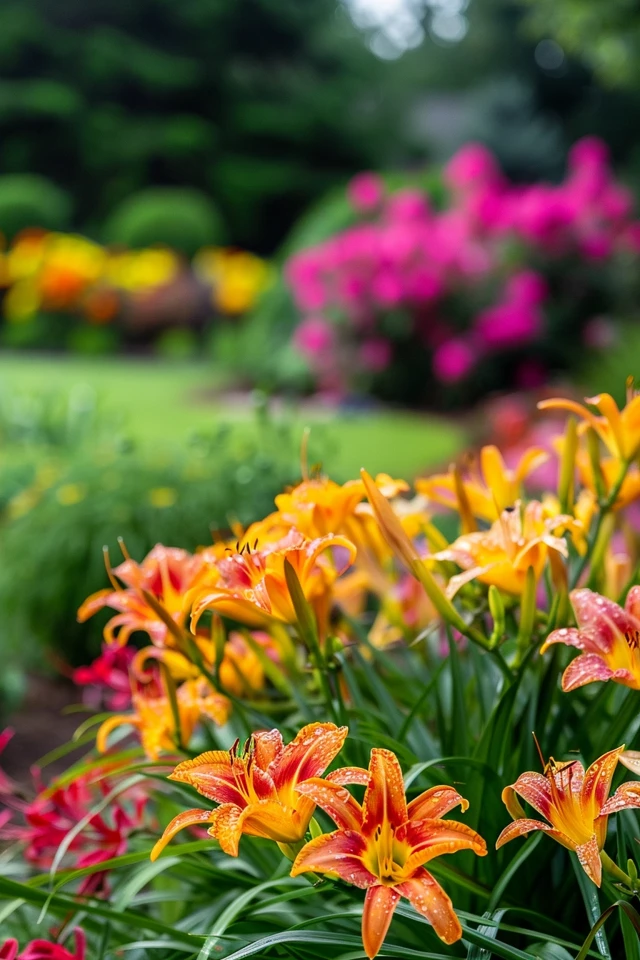Daylilies are versatile and vibrant plants that can transform any garden into a stunning oasis. Whether you’re looking to create a colorful border or design a complete daylily garden, there are plenty of landscaping ideas to explore. Incorporating daylilies into your landscape design can add a pop of color, attract pollinators, and create visual interest. From planting companions to garden layouts, there are endless possibilities for incorporating daylilies into your garden design. Let’s explore some inspiring daylily landscaping ideas to create a vibrant and captivating outdoor retreat.
Key Takeaways
- Daylilies are versatile plants that can add color and visual interest to your garden.
- Incorporating daylilies into your landscape design can attract pollinators and create a vibrant outdoor retreat.
- Planting daylilies in a border or designing a complete daylily garden are popular landscaping ideas.
- Consider using companion plants like coneflowers, black-eyed Susans, or ornamental grasses to enhance the visual appeal of your daylily garden.
- Proper care and maintenance, including watering, deadheading, and regular division, are essential for healthy daylilies.
Companion Plants for Daylilies: Enhancing Visual Appeal and Ecosystem
Pairing daylilies with the right companion plants can greatly enhance the visual appeal of your garden and create a healthy ecosystem. By carefully selecting and incorporating companion plants, you can create a dynamic and harmonious garden design.

Perennial Flowers
Perennial flowers such as coneflowers, black-eyed Susans, and asters make excellent companion plants for daylilies. These flowers provide contrasting colors and bloom at different times throughout the season, ensuring a continuous display of vibrant blooms in your garden.
Ornamental Grasses
To add texture and movement to your daylily garden, consider incorporating ornamental grasses like feather reed grass and blue fescue. These grasses not only complement the daylilies but also create a visually appealing backdrop for the vibrant blooms.
Flowering Shrubs and Trees
For height and structure in your garden, include flowering shrubs like hydrangeas or flowering trees like crabapples. These plants not only provide a focal point but also add depth and variety to your daylily garden.
Native Plants
Adding native plants, such as milkweed or butterfly weed, can attract beneficial insects like butterflies and bees. These native plants support local pollinators, creating a thriving ecosystem in your garden.
Integrating daylilies with the right companion plants is a creative way to elevate your garden design. Whether you prefer a vibrant and colorful display or a serene and balanced arrangement, incorporating daylilies in your garden design can add beauty, diversity, and ecological value.

Daylily Care and Maintenance Tips for Healthy Plants
To ensure your daylilies thrive in your landscape, proper care and maintenance are essential. When planting daylilies, choose a location with full sun and well-drained soil for optimal growth.
Maintain a consistent watering schedule, keeping the soil evenly moist but not waterlogged. This is particularly important during the hot summer months when daylilies may require more frequent watering.
To encourage continuous flowering, deadhead spent blooms by removing the faded flowers. This not only keeps your daylilies looking tidy but also redirects energy towards new blooms.
It’s crucial to remove any diseased or damaged foliage promptly to prevent the spread of pests or diseases. Regularly inspect your daylilies for signs of pests like aphids or diseases like rust, and take appropriate action if necessary.
Applying a balanced fertilizer in the spring and midsummer will provide essential nutrients for your daylilies. This will help promote healthy growth and vibrant blooms. Follow the manufacturer’s instructions for the recommended amount and application method.
Daylilies can benefit from regular division every few years. Dividing helps control their size and promotes healthier growth. To divide your daylilies, dig up the clumps and carefully separate them into smaller sections. Replant the divided sections in their desired locations.
By following these daylily care and maintenance tips, you can ensure that your plants are healthy and vibrant, enhancing the beauty of your landscape.


